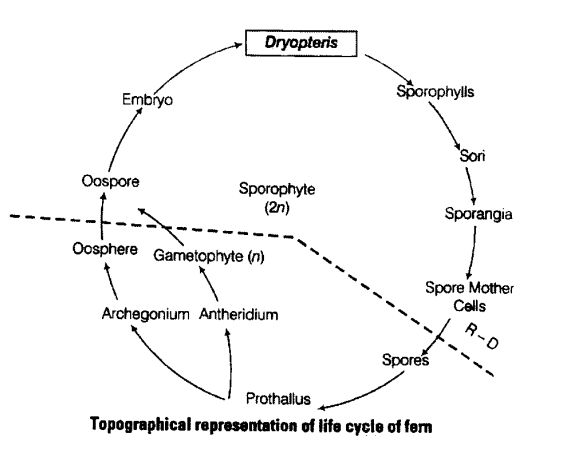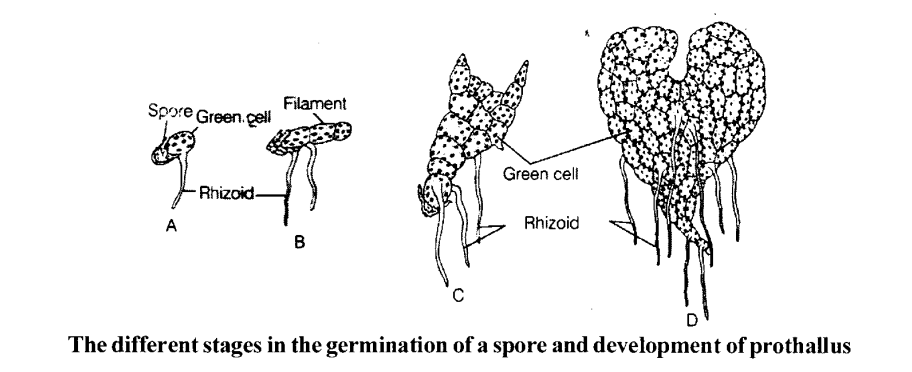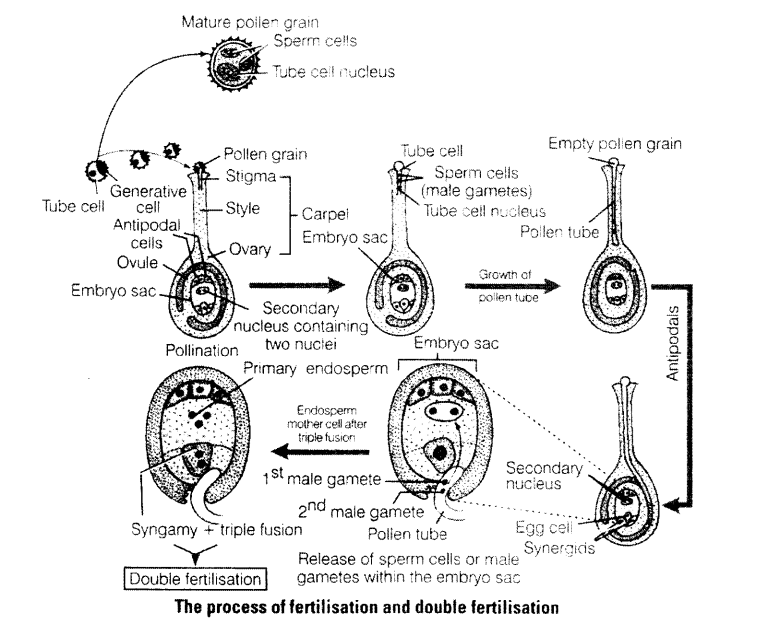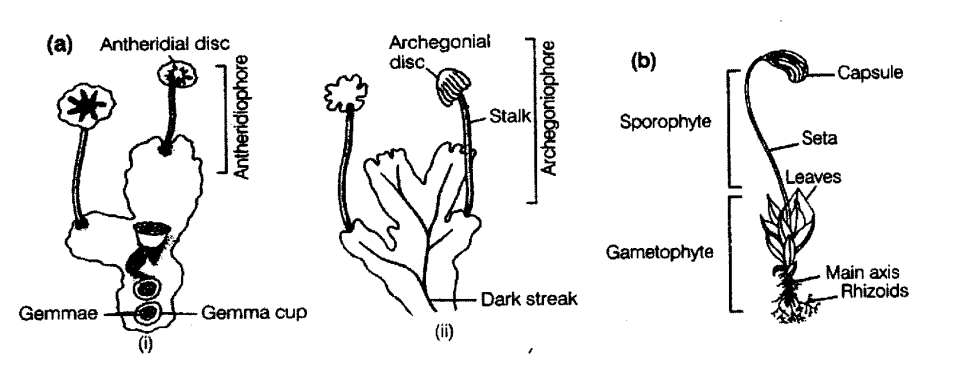NCERT Exemplar Solutions for Class 11 Biology Chapter 3 Plant Kingdom
These Solutions are part of NCERT Exemplar Solutions for Class 11 Biology. Here we have given NCERT Exemplar Solutions for Class 11 Biology Chapter 3 Plant Kingdom.
VERY SHORT ANSWER QUESTIONS
Question 1.
Food is stored as floridean starch in Rhodophyceae. Mannitol is the reserve food material of which group of algae?
Solution:
Mannitol is a reserve food material of the members of Phaeophyceae (brown algae).
Question 2.
The plant body in higher plants is well differentiated and well developed. Roots are the organs used for the purpose of absorption. What is the equivalent of roots in the less developed lower plants?
Solution:
Root like structure called rhizoids are present instead of roots in less developed lower plants (bryophytes and pteridophytes). The plant tissue system in these is not differentiated into true leaf, stem and roots as it is found in higher plants (gymnosperm and angiosperm).
Question 3.
Most algal genera show haplontic life style. Name an alga which is
(a) Haplo diplontic
(b) Diplontic
Solution:
Haplo diplontic type of life cycle is exhibited by Ectocarpus, Polysiphonia and Kelps. The main plant body is saprophytic in Fucus and it shows diplontic type of life cycle.
Question 4.
In bryophytes male and female sex organs are called …………….. and …………..
Solution:
In bryophytes the male sex organ in antheridium and female sex organ is archegonium.
Antheridium produces flagellate antherozoids which are male gametes.
Archegonia is the female part which bears a single egg cell.
SHORT ANSWER QUESTIONS
Question 1.
Why are bryophytes called the amphibians of the plant kingdom? Amphibians can their in water as well as on terrestrial habitat.
Solution:
Bryophytes are a group of primitive plants having a dominant gametophytic plant body. These plants can live in soil but depend on water for movement of male gametes called antherozoids to reach the archegonium (female organ bearing egg cell) so that fertilisation can occur, so bryophytes are called the amphibians of the plant kingdom.
Question 2.
Heterospory, i.e., formation of two types of spores— microspores and megaspores is a characteristic feature in the life cycle of a few members of pteridophytes and all spermatophytes. Do you think heterospory has some evolutionary significance in plant kingdom?
Solution:
- The production of spores of two different sizes and sexes by the sporophytes of land plants is heterospory. Two types ofspores are produced by heterosporic plants.
- Small spores are microspores which germinate into the male gametophyte and large spores are macrospores which develop into the female gametophyte.
- Pteridophytes are intermediate between bryophytes and gymnosperms in the evolution of plants.
- All bryophytes are homosporous and all gymnosperms are heterosporous. This condition is advanced as sexual dimorphism results in cross fertilisation.
- Primitive or earlier pteridophytes are homosporous while later pteriodophytes are heterosporous e.g., Dryopteris, Pteris homosporous Selaginella, Sn/vrao-heterosporous.
Question 3.
Each plant group of plants has some phylogenetic significance in relation to evolution Cycas, one of the few living members of gymnosperms is called as the ‘relic of past’. Can you establish a phylogenetic relationship of Cycas with any other group of plants that justifies the above statement?
Solution:
Cycas is an evergreen plant which resembles palm. It has an unbranched stem and large compound leaves. It exhibits phylogenetic relationship with pteridophyte. Its evolutionary characters include thefollowing:
(i) Growth is redundant.
(ii) Shedding of seed while the embryo is still immature.
(iii) Minimal secondary growth and manoxylic wood.
(iv) Megasporophylls are leaf like.
(v) Sperms are flagellate even when pollen tube is present.
(vi) Leaf bases are persistent.
(vii) Ptysix is circinate.
(viii) Arrangement of microsporangia in well defined archegonia.
Question 4.
Comment on the life cycle and nature of fem prothallus.
Solution:
The life cycle of ferm (Dryopteris) clearly depicts the alternation of generation. The gametophytic stage (n) alternates with the sporophytic stage (2n) in the life cycle as shown in the figure.

The prothallus of the fem is a multicellular, free living, thalloid, haploid and autotrophic structure. It develops from the spores produced by sporophyte after reduction division.
These spore germinate within a germtube with an apical cell and forms a filament of 3-6 cells and one or two rhizoids at the base which later develops into gametophytic plant.

Question 5.
How are the male and female gametophytes of pteridophytes and gymnosperms different from each other?
Solution:
The male and female gametophytes of pteridophytes and gymnosperms different from each other as:

Question 6.
How are the male and female gametophytes of pteridophytes and gymnosperms different from each other?
Solution:
- Symbiosis is a type of interaction of two living organisms where both the associated partners derive some benefit from each other both co¬exist and flourish well.
- Mycorrhiza is a symbiotic association between fungus and the roots of vascular plants. The fungus colonizes the roots of the host either intra or inter cellularly. It helps in the nutrient absorption from soil for the plant.
- Mycorrhizal associations are present in conifers, i.e.,Pinus, Cedrus, Abies and Picea.
- Coralloid roots develop in Cycas. It is produced in clusters at the base of the stem and protrudes out on the ground.
- It is dichotomously branched and greenish in colour. It contains algal zone in cortex.
- This algal zone contains blue green algae like Anabaena and Nostoc which grow in symbiotic association with coralloid roots.
LONG ANSWER QUESTIONS
Question 1.
Explain why sexual reproduction in angiosperms is said to take place through double fertilisation and triple fusion. Also draw a labelled diagram of embryo sac to explain the phenomena.
Solution:
- An angiospermic plants reproduces sexually by the formation of male and female gametes.
- The male gamete is a pollen which contains two male nuclei and the female gamete is an egg cell produced in ovule (female gametophyte).
- The pollen grains germinate on the stigma of a flower and the results in growth of pollen through the tissues of stigma and style and reach the egg apparatus.
- The two male gametes are discharged within the embryo sac. One of the male gamete fuses with the egg cell to form a diploid zygote.
This’fusion is known as fertilisation or syngamy. The second male gamete fuses with the diploid secondary nucleus and forms the triploid Primary Endosperm Nucleus (PEN). This fusion is known as triple fusion. - Because of the involvement of two fusion, this event in angiosperms is termed as double fertilisation. The zygote then develops into embryo and PEN develops into endosperm which provides nourishment to the developing embryo.

Question 2.
Draw labelled diagrams of
(a) Female and male thallus of a liverwort.
(b) Gametophyte and sporophyte of Funaria.
(c) Alternation of generation in angiosperm.
Solution:

(a) Liverworts
(i) Male thallus of Marchantia polymorpha
(ii) Female thallus of Marchantia polymorpha
(b) Funaria
(gametophyte and sporophyte)

We hope the NCERT Exemplar Solutions for Class 11 Biology at Work Chapter 3 Plant Kingdom, help you. If you have any query regarding NCERT Exemplar Solutions for Class 11 Biology at Work Chapter 3 Plant Kingdom, drop a comment below and we will get back to you at the earliest.